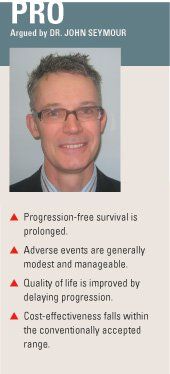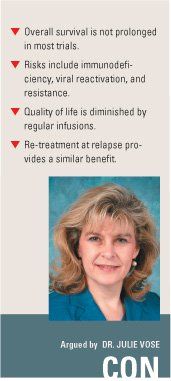Should Maintenance Rituximab for Follicular NHL be Routine?
CHICAGO-Ongoing trials are still clarifying the optimal approach to management after induction therapy for non-Hodgkin’s follicular lymphoma. In the meantime, patients and physicians are left to ponder whether maintenance rituximab (Rituxan) should be used routinely in all cases. Leading researchers in hematology debated this topic in an education session at ASCO 2008.
ABSTRACT: Impressive gains in progression-free survival must be weighed against scant evidence of an improvement in overall survival and some noteworthy risks.
CHICAGO-Ongoing trials are still clarifying the optimal approach to management after induction therapy for non-Hodgkin’s follicular lymphoma. In the meantime, patients and physicians are left to ponder whether maintenance rituximab (Rituxan) should be used routinely in all cases. Leading researchers in hematology debated this topic in an education session at ASCO 2008.
Preventing Relapse
Speaking in support of routine rituximab maintenance, John F. Seymour, MBBS, PhD, of the Peter MacCallum Cancer Centre, Victoria, Australia, noted that despite dramatic improvements in the treatment of follicular lymphoma, patients continue to have relapses, and disseminated disease is incurable.
“Each episode of development of active disease and resumption of therapy impairs the quality of life of our patients, and delaying or avoiding that is beneficial for their enjoyment of life,” he asserted. Moreover, with each subsequent treatment of similar intensity, the duration and quality of remission decrease.
Maintenance therapy should keep disease in remission, improve the quality of remissions, and delay time to next therapy, Dr. Seymour said.
“Ideally, if we can achieve it, the most robust endpoint is that of an improvement of overall survival, and, pleasingly, there are a number of well-designed trials that show that in a number of contexts, we can actually achieve that with maintenance rituximab,” he commented.
Five Trials
Dr. Seymour first discussed the SAKK 35/98 trial, in which patients with untreated or relapsed/refractory follicular lymphoma received four doses of rituximab, and those with at least stable disease were randomized to observation or maintenance rituximab (Ghielmini M et al: Blood 103:4416-4423, 2004).
Median event-free survival was significantly better-almost doubled-with rituximab maintenance (23.2 vs 11.8 months), he noted. Furthermore, post hoc analyses showed trends toward longer durations of response in both the treatment-nave and pretreated subgroups.
In the ECOG 1496 trial, patients with untreated NHL who had at least stable disease after chemotherapy were randomized to rituximab maintenance or observation (Hochster HS et al: ASH 2005, abstract 349).
Median progression-free survival in the follicular lymphoma subgroup was significantly and dramatically better with maintenance (5 years vs 15 months), Dr. Seymour pointed out.
“To my surprise, overall survival, even in the follicular lymphoma subgroup, was also improved in this group who received maintenance rituximab,” he added, with a 4-year rate of 88% vs 72% (P = 0.03), albeit with 1-sided statistical testing.
A third randomized trial, conducted by the Minnie Pearl Cancer Research Network, compared maintenance rituximab vs re-treatment with rituximab at the time of progression in patients who had relapsed/refractory NHL after prior chemotherapy, received rituximab, and had at last stable disease (Hainsworth JD et al: J Clin Oncol 23:1088-1095, 2005).
In the follicular lymphoma group, median progression-free survival was significantly better with the maintenance therapy approach (33 vs 13 months), Dr. Seymour said.
In the EORTC 20981 trial, patients with follicular lymphoma in first or second relapse were randomized to CHOP vs R-CHOP, and those experiencing a partial or complete remission were further randomized to rituximab maintenance or observation (van Oers MH et al: Blood 108:3296-3301, 2006).
Again, progression-free survival was significantly better, by about 3 years, with rituximab maintenance (51.5 vs 14.9 months). Moreover, the findings were similar regardless of the initial treatment (CHOP vs R-CHOP) and initial extent of remission (complete vs partial).
The 3-year rate of overall survival was significantly better with maintenance in the entire study population (85% vs 77%) but not within the initial treatment subgroups (CHOP and R-CHOP) individually.
Dr. Seymour pointed out that with the exception of higher rates of grade 3-4 neutropenia and a modest increase in infections with maintenance, rates of adverse events did not differ.
In a fifth trial, the German Low-Grade Lymphoma Study Group (GLSG) trial, patients with advanced, relapsed/refractory follicular or mantle cell lymphoma were randomized to FCM (fludarabine, cyclophosphamide, mitoxantrone) with or without rituximab, and those with a partial or complete remission were further randomized to maintenance rituximab or observation (Forstpointner R et al: Blood 108:4003-4008, 2005).
The median duration of response was significantly better with maintenance in the population overall (not reached vs 17 months), as well as in the subset with follicular lymphoma who received R-FCM (not reached vs 26 months). In this trial, the only adverse event that was more common with rituximab was grade 3-4 neutropenia.
Cost-effectiveness
Turning to cost-effectiveness, Dr. Seymour noted that a recent analysis conducted from the UK perspective found that maintenance rituximab vs none after chemotherapy alone costs about $30,000 per quality adjusted life-year (QALY), and maintenance rituximab after combined rituximab-chemotherapy costs about $86,000/QALY (Gajraj E et al: Lancet Oncol 9:320-321, 2008).
“So, compared to other medically acceptable interventions, this is certainly an acceptable cost to our society,” he commented.
Dr. Seymour concluded that “there are very robust, very uniform benefits for rituximab maintenance, which have now been confirmed in five randomized trials. The benefits are seen consistently in previously untreated and previously treated patients, whether they received chemotherapy alone, rituximab monotherapy, or combination rituximab/chemotherapy at relapse.”
He characterized toxicity as modest and manageable, and asserted that data support this therapy’s cost-effectiveness.
A Stricter Definition
Speaking against the use of rituximab maintenance in all patients with follicular lymphoma, Julie M. Vose, MD, of the University of Nebraska Medical Center, Omaha, first noted that she adheres to a stricter definition of rituximab maintenance.
“I think its use after chemotherapy alone is actually not a maintenance strategy but just another treatment strategy,” she explained. Therefore, she did not include the ECOG 1496 trial results in her discussion.
Compelling evidence of an overall survival benefit is lacking, Dr. Vose argued. For example, in the Minnie Pearl trial, this outcome did not differ between maintenance rituximab vs re-treatment at the time of progression.
Moreover, the duration of rituximab benefit was not improved by maintenance (with nearly 80% of patients in both groups requiring another conventional therapy by 5 years), and maintenance patients received many more courses of the drug (117 vs 83).
“So, the overall cost-benefit ratio also favored re-treatment,” Dr. Vose commented.
In addition, in the GLSG trial, there was only a trend toward better overall survival with maintenance rituximab after R-FCM induction, and in the EORTC 20981 trial, this endpoint was not improved among patients who received R-CHOP induction.
“So taking that into clinical practice [where previous receipt of rituximab is common], I think that you can see that’s going to apply to most of our patients,” she observed.
Risk of Immunodeficiency
At the same time, maintenance rituximab can lead to immunodeficiency, Dr. Vose pointed out.
For example, in the SAKK trial, patients in the rituximab group had prolonged B-cell depletion and hypogammaglobulinemia, with a decrease in IgM levels from baseline of 86% at 3 months and of 72% at 12 months.
Likewise, in the EORTC 20981 trial, median IgG levels were significantly lower with rituximab maintenance than with observation (6.3 vs 7.3 g/L).
Patients can also experience delayed cytopenias, especially neutropenia and thrombocytopenia, she added, and these can lead to further complications, such as the higher rate of grade 3-4 infection observed in the EORTC trial (9% vs 2.4%). Additionally, pulmonary toxicity and cardiotoxicity have been reported, she said.
Reactivation of Viruses
Maintenance rituximab therapy can also trigger reactivation of viruses, Dr. Vose pointed out, most notably hepatitis B virus and JC virus, which causes progressive multifocal leukoencephalopathy (PML).
The latter “is an association that has now been confirmed by many different investigators, and, unfortunately, I have seen this myself,” she commented.
In a preliminary series of 29 cases of PML associated with rituximab therapy, all occurred in patients receiving additional therapies, she noted (updated results were reported at the ASCO meeting by Carson KR et al, abstract 8531).
Patients in this series had received a median of six doses of rituximab. The median time between PML diagnosis and death was only 2 months, she said.
Clinicians should also be aware that maintenance rituximab leads to a decreased response to vaccination antigens by impairing both the primary and recall humoral immune responses, Dr. Vose observed.
In other words, she explained, patients can no longer be initially vaccinated or re-vaccinated against some of the infectious illnesses that are of concern in the oncology population.
Reduced Quality of Life?
Taking up the issue of quality of life, Dr. Vose called attention to the time and inconvenience of rituximab maintenance.
“Is coming in every few months or every week to get rituximab at the cancer center a good quality of life, or is it a better quality of life to go about your activities and, eventually, when the lymphoma may come back, to come back in for treatment?” she asked.
A final concern she mentioned is the emergence of resistance. “As these patients are treated over and over and over again with rituximab, they do become rituximab refractory,” she said, and refractory disease is very difficult to treat.
“Maintenance rituximab should be used in a very limited fashion,” Dr. Vose asserted. “Currently, there is very little evidence for a survival benefit in most of our trials, and re-treatment at relapse provides a very similar benefit.”
When using maintenance rituximab, she recommended that clinicians refer to clinical trial results and guidelines for guidance.
In particular, patients in trials have generally been treated for 2 years at most, whereas patients in clinical practice are often being treated for much longer.
“I think that’s not appropriate,” she concluded. “We have to be concerned about the long-term effects.”


Highlighting Insights From the Marginal Zone Lymphoma Workshop
Clinicians outline the significance of the MZL Workshop, where a gathering of international experts in the field discussed updates in the disease state.